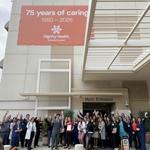Maurice Friera knows the impacts of naloxone more intimately than most people. The nasal spray used for reversing opioid-induced overdoses, also known by the popular brand name Narcan, has not only saved his own life, but he has revived others with it as well.
“My first experience with Narcan was when I was still in my active addiction,” Friera said. “It was when fentanyl was new to the streets. I was administering Narcan, and Narcan was administered to me multiple times.”
The 36-year-old Belmont resident entered long-term recovery from substance abuse disorder “in handcuffs,” as he puts it, when he was booked into San Mateo County Jail facing close to two decades behind bars. After completing a recovery program while incarcerated, he was released on a suspended sentence with one of the conditions being that he complete a recovery program through Our Common Ground, a treatment center. Since then, Friera has paid it forward by working as a counselor and intake coordinator at several recovery centers throughout the Bay Area.
But while Friera’s path is a hopeful one, many others remain in the throes of the destructive opioid epidemic, which continues to affect the Bay Area. Naloxone administration by ambulance staff in San Mateo County increased by an average of 30% year over year between 2019 and 2022. Though 2023 data is incomplete and subject to change, preliminary figures suggest that ambulance staff are administering naloxone at higher rates than in 2022.
Nationally, the Food and Drug Administration approved naloxone nasal spray for over-the-counter use in March, reflecting the ongoing need to get the medication into as many hands as possible. And California’s Naloxone Distribution Project, which is the main source of naloxone for many local agencies, has recently struggled to keep up with demand.
In response to the ongoing crisis, more agencies and organizations in the county are opting to store Narcan on-premise as well. For Jefferson Union High School District, as well as many other school districts, the 2022-23 school year marked the first time that naloxone and subsequent training were available on-site in all schools.
Dorene Basuino, associate superintendent of Student Services and Human Resources at Jefferson Union High School District, was impressed by how many employees voluntarily attended training, but it became quickly apparent that many of the attendees had been personally affected by the opioid crisis.
“Some people were getting triggered [during the training], because it was emotional for them,” Basuino said. “We started telling people at the beginning, ‘If this is personal to you, take a breath, walk out and come back in when you’re ready.’ It just goes to show how prevalent this is.”
According to Clara Boyden, deputy director of Alcohol and Other Drug Services at San Mateo County Health, the opioid epidemic has indeed proven that its impact reaches people from all backgrounds.
“Trauma and stress can be drivers of addiction, but it’s still an equal opportunity disease. No one is immune from having a family get hooked on a prescription opioid after surgery and then struggle with addiction,” Boyden said.
And as someone who works for recovery centers in both San Francisco and San Mateo County, Friera can attest to how the crisis is alive and well in both areas.
“In San Francisco, you see it all over the place. It’s on the sidewalks, and it’s in your face. In San Mateo County, you’ll see it, but it’s not as spotlighted as it is in San Francisco. It’s a little more hidden behind closed doors and in homeless encampments, but it’s definitely there,” he said.
Recommended for you
Many strategies have been deployed throughout the Bay Area to address the problem, including harm reduction, an approach that aims to reduce the negative impacts of drug use, such as overdose and disease transmission, without requiring that recipients of such services necessarily abstain from using illicit drugs. They range from safe consumption sites to programs that distribute fentanyl test strips, so individuals can verify if their drug supply contains the potentially lethal substance.
While some of these approaches are a critical means of intervention for those who want help, they must also be used in conjunction with programs that do not help them continue to use drugs, according to Friera. He cites homelessness as a problem typically related to issues surrounding mental health and substance abuse but is not always treated as such.
“Trying to address homelessness without addressing someone’s mental health or addiction won’t solve the problem. But if you only try to solve the addiction, then once you’re done with a recovery program, you’re back in survival mode about where you’re going to go, which is a very vulnerable place to be,” he said. “It all has to be addressed together.”
Even though increasingly easy access to Narcan signals evidence of progress, much work remains, including the misconceptions around naloxone that health professionals must still combat.
“A lot of people were initially concerned about whether or not they could administer it if someone isn’t actually overdosing. You cannot hurt anyone by administering it, even if they’re not overdosing,” Boyden said.
“The other thing that some people thought was that it might be an opioid medication, which it is not. It’s very safe and easy to use.”
And keeping up to date with new drugs infiltrating opioids is no small feat.
Heightened incidents of fentanyl laced with the dangerous substance xylazine has made overdose efforts more complicated, as the animal tranquilizer is not an opioid and thus resistant to Narcan. In March, the Drug Enforcement Agency issued a warning that they had seized xylazine and fentanyl mixtures in 48 out of 50 states, and the San Mateo County crime lab has reported at least several positive xylazine results.
Still, public health experts recommend administering naloxone even if it is uncertain whether or not they’re experiencing an opioid overdose.
As for Friera, Narcan will continue to be a part of his life for the foreseeable future.
“I have Narcan in my car every time I go to work. My partner keeps Narcan in her car. It becomes routine to have on you,” he said. “[When I leave the house], I make sure I have my cellphone, keys, wallet, then Narcan.”






























(0) comments
Welcome to the discussion.
Log In
Keep the discussion civilized. Absolutely NO personal attacks or insults directed toward writers, nor others who make comments.
Keep it clean. Please avoid obscene, vulgar, lewd, racist or sexually-oriented language.
Don't threaten. Threats of harming another person will not be tolerated.
Be truthful. Don't knowingly lie about anyone or anything.
Be proactive. Use the 'Report' link on each comment to let us know of abusive posts.
PLEASE TURN OFF YOUR CAPS LOCK.
Anyone violating these rules will be issued a warning. After the warning, comment privileges can be revoked.